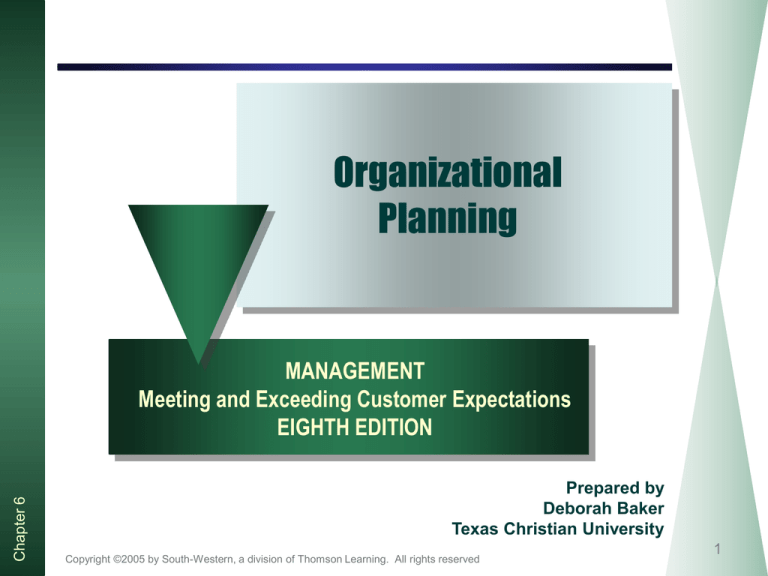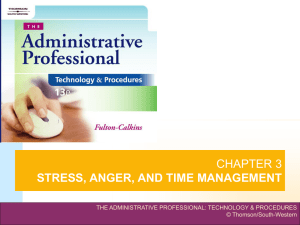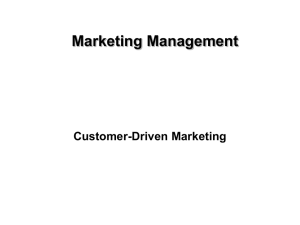
Organizational
Planning
Chapter 6
MANAGEMENT
Meeting and Exceeding Customer Expectations
EIGHTH EDITION
Prepared by
Deborah Baker
Texas Christian University
Copyright ©2005 by South-Western, a division of Thomson Learning. All rights reserved
1
learning objectives
1. Explain the importance of planning
2. Describe the importance of an organization’s
mission statement
3. Discuss the purposes of strategic, tactical,
operational, and contingency plans
4. Explain the relationships between strategic,
tactical, and operational goals
5. List and explain the steps in a basic planning
Chapter 6
process
6. Discuss various ways to make plans effective
7. Describe the barriers to planning
Copyright ©2005 by South-Western, a division of Thomson Learning. All rights reserved
2
Planning
1
Chapter 6
Planning
Preparing for tomorrow, today
Copyright ©2005 by South-Western, a division of Thomson Learning. All rights reserved
3
Planning Responsibilities
Chapter 6
1
1.
Construct, review, and/or rewrite
organization’s mission
2.
Identify and analyze their opportunities
3.
Establish the goals they wish to achieve
4.
Identify, analyze, and select the course(s)
of action required to reach goals
5.
Determine resourced needed to achieve
goals
Copyright ©2005 by South-Western, a division of Thomson Learning. All rights reserved
4
2
Mission Statement
Chapter 6
Mission
Statement
When a mission is formalized in
writing and communicated to all
organizational members
Copyright ©2005 by South-Western, a division of Thomson Learning. All rights reserved
5
Mission Statement
2
Includes references to core values and
principles
Serves as an operational and ethical guide
Serves as the foundation and coordinating
Chapter 6
device for the:
– execution of management functions
– behaviors of organizational members
– shaping of the organization’s culture
Copyright ©2005 by South-Western, a division of Thomson Learning. All rights reserved
6
2
Mission Statement Questions
What is our business?
Chapter 6
What should it be?
From Peter Drucker
Copyright ©2005 by South-Western, a division of Thomson Learning. All rights reserved
7
2
Rules for Mission Statements
Rule #1: Keep the statement simple; not necessarily short, but
simple.
Rule #2: Allow companywide input.
Rule #3: Involve outsiders. They can bring clarity and a fresh
perspective to the statement-writing process.
Rule #4: Develop the wording and the tone to reflect the
company’s personality or what the company would like to be.
Rule #5: Share the mission statement in as many creative ways
as possible and in as many languages as necessary. Keep it in
front of people constantly.
Chapter 6
Rule #6: Rely on the mission statement for guidance. Challenge
it continually, and judge employees by how well they adhere to its
tenets. Management must say it and live it.
Source: From Say it and Live It by Patricia Jones and Larry Kahaner. Copyright © 1995 by Kane Associates International, Inc.
Used by permission of Doubleday, a division of Bantam Doubleday Dell Publishing Group, Inc.
Copyright ©2005 by South-Western, a division of Thomson Learning. All rights reserved
8
Effective Goals and Objectives
Chapter 6
2
Characteristic
Explanation
Specific and measurable
Not all objectives can expressed in numeric
terms, but they should be quantified when
possible.
Realistic and challenging
Impossibly difficult objectives demotivate
people. Objectives should be challenging
but attainable.
Focused on key result areas
Goals should focus on key results--sales,
profits, production, or quality.
Cover a specific period
A measurable objective is stated in terms of
the time in which it is to be completed.
Short-term goals should complement longterm goals.
Reward performance
Objectives are meaningless if they are not
directly related to rewards for performance.
Copyright ©2005 by South-Western, a division of Thomson Learning. All rights reserved
9
Plans
2
Plan
The end result of the planning
effort—
Chapter 6
Commits individuals,
departments, entire
organizations, and the resources
of each to specific courses of
action for days, months, and
years into the future
Copyright ©2005 by South-Western, a division of Thomson Learning. All rights reserved
10
Plans
Chapter 6
2
What
identifies the specific goals to be
accomplished
When
answers a question of timing
Where
concerns the place(s) where the plan will
be executed
Who
identifies specific people who will
perform tasks essential to the plan
How
involves the specific actions to be taken
to reach the goals
How much
is concerned with the expenditure of
resources needed to reach the goals
Copyright ©2005 by South-Western, a division of Thomson Learning. All rights reserved
11
Stretch Goals
2
Chapter 6
Stretch Goals
The end result of the planning
goals that require great leaps
forward
Copyright ©2005 by South-Western, a division of Thomson Learning. All rights reserved
12
2
Strategies and Tactics
Strategy
Chapter 6
Tactic
A course of action created to
achieve a long-term goal
A course of action created to
achieve a short-term goal
—an objective
Copyright ©2005 by South-Western, a division of Thomson Learning. All rights reserved
13
2
Determining Resource Requirements
People
Technology
Money
Information
Chapter 6
Supplies
Facilities
Equipment
Copyright ©2005 by South-Western, a division of Thomson Learning. All rights reserved
14
Types of Plans
3
Chapter 6
Mission
Strategic
Plans
Strategic
Goals
Tactical
Plans
Tactical
Objectives
Operational
Plans
Operational
Objectives
Copyright ©2005 by South-Western, a division of Thomson Learning. All rights reserved
15
3
Strategic Plans and Goals
Strategic
Plans
Chapter 6
Strategic
Goals
Contains the answers to who,
what, when, where, how, and
how much for achieving
strategic goals
Long-term, companywide goals
set by top-management strategic
planning efforts. Focus on the
changes desired in productivity,
product innovation, and
responsibilities to stakeholders
Copyright ©2005 by South-Western, a division of Thomson Learning. All rights reserved
16
3
An Organization’s Mission and Level of Goals
Mission
CEO and
Board of Directors
Strategic Goals
Top-Level
Management
Chapter 6
Tactical Objectives
Middle-Level
Management
Operational Objectives
First-Line
Management
Operational Objectives
First-Line
Management
Copyright ©2005 by South-Western, a division of Thomson Learning. All rights reserved
17
3
Tactical Plans and Objectives
Tactical
Plan
Developed by middle managers,
this plan has more details,
shorter time frames, and
narrower scopes than a strategic
plan
Usually spans one year or less
Chapter 6
Tactical
Objectives
Short-term goals set by middle
managers that must be achieved
in order to reach top
management's strategic goals
and the short- and long-term
goals of middle managers
Copyright ©2005 by South-Western, a division of Thomson Learning. All rights reserved
18
3
Operational Plans and Objectives
Operational
Plan
The first-line manager’s tool for
executing daily, weekly, and
monthly activities
• Single-Use Plans
• Standing Plans
Chapter 6
Operational
Objectives
The specific results expected
from first-level managers, work
groups, and individuals
Copyright ©2005 by South-Western, a division of Thomson Learning. All rights reserved
19
3
Operational Plans
Single-Use Plans
Standing Plans
Programs
Policies
Procedures
Rules
Chapter 6
Budgets
Copyright ©2005 by South-Western, a division of Thomson Learning. All rights reserved
20
Chapter 6
4
Unified Hierarchy of Goals
Copyright ©2005 by South-Western, a division of Thomson Learning. All rights reserved
21
4
Contingency Plans
Chapter 6
Contingency
Plan
An alternative goal and course
or courses of action to reach
that goal if and when
circumstances and assumptions
change so drastically as to make
an original plan unusable
Copyright ©2005 by South-Western, a division of Thomson Learning. All rights reserved
22
Basic Planning Process
Chapter 6
5
Step 1
Setting Objectives
Step 2
Analyzing and Evaluating the Environments
Step 3
Identifying the Alternatives
Step 4
Evaluating the Alternatives
Step 5
Selecting the Best Solution
Step 6
Implementing the Plan
Step 7
Controlling and Evaluating the Results
Copyright ©2005 by South-Western, a division of Thomson Learning. All rights reserved
23
5
Analyzing and Evaluating the Environment
Internal Environment
Availability of resources
Needs of internal customers
External Environment
Strengths and weaknesses of suppliers
Chapter 6
and partners
Availability of labor and technology
Needs of external customers
Copyright ©2005 by South-Western, a division of Thomson Learning. All rights reserved
24
6
Making Plans Effective
Basis for Planning
Assumptions
Chapter 6
Forecasts
Copyright ©2005 by South-Western, a division of Thomson Learning. All rights reserved
25
6
Making Plans Effective
Increasing the Probability of Success
Effective communication
Quality of information
Chapter 6
Involvement of others
Copyright ©2005 by South-Western, a division of Thomson Learning. All rights reserved
26
6
Planning Tools
MBO
Management
by Objectives
Chapter 6
Linear
Programming
A technique that emphasizes
collaborative setting by
managers and their
subordinates
A planning tool that can be used
to determine the optimum
combination of resources and
activities
Copyright ©2005 by South-Western, a division of Thomson Learning. All rights reserved
27
7
Barriers to Planning
Inability to plan
Lack of commitment to the planning process
Inferior information
Lack of focus on the long term
Overreliance on the planning department
Chapter 6
Overemphasis on controllable variables
Copyright ©2005 by South-Western, a division of Thomson Learning. All rights reserved
28







